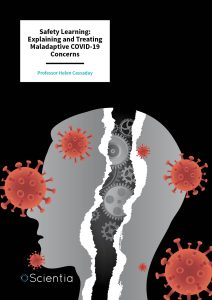Professor Helen Cassaday | Safety Learning: Explaining and Treating Maladaptive COVID-19 Concerns
Safety signals are learned cues that predict the non-occurrence of an aversive event and are effective in inhibiting fear and maintaining fear-motivated behaviours in anxious individuals. However, the role of inhibitory learning mechanisms in producing ‘conditioned inhibitors’ in response to safety signals has received little attention. The need to better understand this has become more pressing given the increased levels of health anxiety and safety behaviours resulting from the COVID-19 pandemic. Professor Helen Cassaday at the University of Nottingham and colleague Dr Meghan Thurston have evaluated the role that safety learning plays in anxiety, inhibitory learning and concerns about COVID-19.
Understanding Fear and Anxiety in the Evolutionary Context
Fear and anxiety are entirely normal – in fact, essential – emotions. When we are anxious or frightened, adrenalin is released into the bloodstream, increasing our heart rate and the blood flow to the heart and muscles. This hard-wired ‘fight or flight’ response is critical to our survival.
In an evolutionary context, (re)actions which remove threats enhance our survival and are thus reinforced through natural selection. Those who do not respond sufficiently to a threat are less likely to survive, and therefore, appropriate levels of anxiety and fear are necessary.
There is a need to better understand the functional role of fear and anxiety in our modern times. Too much anxiety can affect well-being, whereby some individuals over-respond to potential threats by developing maladaptive avoidance behaviours to remove themselves from the situation. So, while responding to threat can be a proportional and appropriate response, depending on the situation, it may also be harmful and counterproductive.
The recent COVID-19 pandemic is a good example of the demand for a delicate balancing act in how we respond to threat. Individuals who failed to avoid the threat may have put themselves and their families at increased risk of contracting the virus. On the other end of the spectrum, some individuals experienced severe health anxiety and adopted safety behaviours which were counterproductive.
The COVID-19 pandemic has put a new perspective on the complexity of how we respond to threat and the presumptions that safety behaviours should be eliminated. As such, current therapeutic options need to be re-evaluated. Professor Helen Cassaday from the University of Nottingham and colleague Dr Meghan Thurston recently published a perspective article on the role of safety learning in anxiety, based on experimental models of inhibitory learning. Their evidence-based analysis progresses our understanding of the role of safety learning relating to COVID-19 and its impact on mental health.
Safety Learning and Anxiety
Learning about threats is a fundamental survival behaviour in which we associate previously neutral stimuli with adverse events, and as a consequence initiate defensive behaviours to prevent direct harm. However, the failure to inhibit these threat responses in environments which are actually safe means that these survival behaviours can become dysfunctional and contribute to inappropriate and excessive levels of anxiety.
Safety learning is the process by which a stimulus becomes associated with the absence of threat. It is currently a poorly understood concept compared to threat learning but is emerging as a topic of interest. Individuals adopt safety behaviours in an effort to prevent their fears from becoming realised and to allow them to feel more comfortable in situations they are anxious about. If an individual believes that a situation will not go well, they are likely to feel anxious and have the urge to avoid the situation.
Short-term safety behaviours can give a sense of relief but in the long term, they often prove unhelpful. Animal studies confirm that safety signals – learned cues that indicate threat is unlikely – moderate reaction to stress and help to buffer the effects of uncontrollable stressors.
Although there are effective treatments, the underlying mechanisms of various anxiety disorders are still not fully understood and they have multiple causes. Individuals who have anxiety disorders report awareness of a variety of safety signals – such as the presence of a trusted person and the knowledge they have medication to hand. The main treatment is cognitive behavioural therapy, in which one approach is to encourage individuals to drop their safety behaviours. Clinically, there is mixed evidence in support in terms of effectiveness but it remains the generally favoured approach. Removal of the safety behaviour may be combined with strategies for the individual to reflect on the absence of a negative outcome occurring.

Safety Learning in the Context of COVID-19
The most theoretically sound experimental model of safety learning is arguably conditioned inhibition. Conditioned inhibition is a more general learning phenomenon, in which a stimulus that predicts the absence of an otherwise expected outcome comes to control how an organism (be that an animal or human subject) responds to it.
Scientists are becoming increasingly interested in the development of safety behaviours in humans and how best to manage these therapeutically. The safety learning approach has yet to be applied to the context of understanding the mental health impact of the COVID-19 pandemic but it has clear relevance. For example, people may initially sanitise and wash their hands to reduce the risk of infection, however, the safety signals provided by the smell of sanitiser and soap will come to secondarily reinforce this behaviour. Individuals with obsessive-compulsive disorder have been identified as being particularly susceptible to the development of such behaviours. However, there is also some evidence of increased anxiety and bias towards the direction of attention towards virus-related threats compared to pre-pandemic levels in the general population as well.
Theoretical and Therapeutic Implications
Professor Cassaday and Dr Thurston conclude that while remote cognitive behavioural therapy has been somewhat effective as COVID-19 restrictions relaxed and the immediate threat waned, there is much yet to be explored in the emerging application of interventions relating to COVID-19. Safety signals prevent conditioned fear from being removed and their removal or extinction has been the focus of therapeutic intervention for anxiety disorders to date.
Unfortunately, COVID-19 has resulted in a complex and ever-changing situation. As new variants arise and the threat waxes and wanes, safety behaviours will need to be judged in this context as they may prove entirely rational. As such, each individual’s risk, vulnerability and personal situation will need to be taken into account when deciding their best course of action. If, as we hope, COVID-19 is now behind us, the next pandemic may still be around the corner, and we must prepare. Similar considerations will apply. Professor Cassaday and Dr Thurston argue that perhaps the most pressing need is to identify whether safety behaviours are increased or decreased in connection with different anxiety-related disorders and concerns.
SHARE
DOWNLOAD E-BOOK
REFERENCE
https://doi.org/10.33548/SCIENTIA912
MEET THE RESEARCHER

Professor Helen Cassaday
School of Psychology
University of Nottingham
Nottingham
UK
Professor Helen Cassaday received a degree in Experimental Psychology from the University of Oxford before going on to complete a PhD in psychopharmacology at the Institute of Psychiatry at the University of London. She returned to Oxford in 1990 and worked as a Postdoctoral Research Associate in the Department of Psychology before moving to the School of Psychology at the University of Nottingham in 1996, where she initially took up the post of Lecturer. Throughout the years, she progressed through the academic ranks at the University of Nottingham, being promoted to full Professor of Behavioural Neuroscience in 2016, the position she still holds today. She has expertise and extensive experience in the fields of psychopharmacology, behavioural neuroscience and experimental psychology. Her research focuses on the underlying biology of associative learning processes which are fundamental to normal cognition.
CONTACT
E: helen.cassaday@nottingham.ac.uk
W: https://psychology.nottingham.ac.uk/staff/hjc/
KEY COLLABORATOR

Dr Meghan Thurston currently works as a Consultant Clinical Psychologist in the NHS. She completed a BSc(Hons) in Biology, and a PhD in Behavioural Neuroscience at the University of Nottingham before completing her Doctorate in Clinical Psychology at the University of Leicester. Her academic work has focused on anxiety disorders, inhibitory learning, and mental health in transgender healthcare. This has led to several publications in peer-reviewed journals. Since qualification, Dr Thurston has worked in Paediatrics at the Royal Derby Hospital and in Transgender Healthcare at the Nottingham Centre for Transgender Health where she is the Consultant Clinical Psychologist and Lead for Psychology and Psychotherapy. Dr Thurston continues to maintain involvement in research and has a passion for education, training, and supervision.
E: meghan.thurston2@nottshc.nhs.uk
FUNDING
Biotechnology and Biological Sciences Research Council [Grant Number: BB/S000119/1]
University of Nottingham School of Psychology PhD studentship (awarded to Meghan Thurston)
FURTHER READING
MD Thurston, HJ Cassaday, Safety Learning in Anxiety, Pavlovian Conditioned Inhibition and Covid Concerns, Frontiers in Psychology, 2022, 13. DOI: https://doi.org/10.3389/fpsyg.2022.866771

REPUBLISH OUR ARTICLES
We encourage all formats of sharing and republishing of our articles. Whether you want to host on your website, publication or blog, we welcome this. Find out more
Creative Commons Licence (CC BY 4.0)
This work is licensed under a Creative Commons Attribution 4.0 International License. 
What does this mean?
Share: You can copy and redistribute the material in any medium or format
Adapt: You can change, and build upon the material for any purpose, even commercially.
Credit: You must give appropriate credit, provide a link to the license, and indicate if changes were made.
SUBSCRIBE NOW
Follow Us
MORE ARTICLES YOU MAY LIKE
Dr Ralf Adam | New Technologies Shaping the Future of Oral Hygiene
Understanding the efficiency of various toothbrush technologies is essential for achieving optimal oral health. Dr Ralf Adam, who leads a dedicated team at Procter & Gamble in Germany, is keen to investigate the complexities of these technologies. His team have provided new insights into the best toothbrush types for plaque removal and the maintenance of gum health. By highlighting the importance of informed oral care decisions and ongoing investigations, this vital research works towards ensuring everyone can achieve a brighter, healthier smile.
Dr Toby Phesse | Revealing the Mysteries of Wnt Signalling: Novel Approaches to Beating Cancer
Cancer remains a leading cause of mortality worldwide, and the need for new, more effective treatments remains an urgent challenge. Dr Toby Phesse from Cardiff University in the UK focuses on the role of the Wnt receptor found on the surface of cells and its involvement with cell communication and cancer growth, bringing fresh hopes for new therapeutic options.
Dr Vijay Reddy | The Virus World Database: An Invaluable Resource for Public Health and Healthcare
Severe viral disease presents an ongoing challenge to the health of humankind. While unparalleled developments in science and technology are improving our understanding of such viruses, this information needs to be readily accessible to researchers to ensure continued progress in public health and healthcare. Dr Vijay Reddy and his colleagues at the Hormel Institute (University of Minnesota) developed the Virus World database, an invaluable resource that details the genome, structure, and host of practically every discovered virus to date.
Professor Ralf Herwig | Deciphering the Enigma of Vitamin D and the Immune System
Vitamin D has been studied as a treatment for a large number of diseases and conditions, from cancer to autism to COVID-19. However, its mode of action is not completely understood. Professor Ralf Herwig carries out his research at HG Pharma GmbH (Austria) and Ulster University (UK). His vital work explores the role of vitamin D in the body with a view to unlocking its potential as a treatment for a variety of health conditions involving the immune system.





